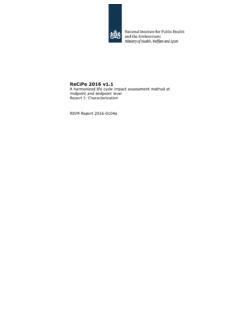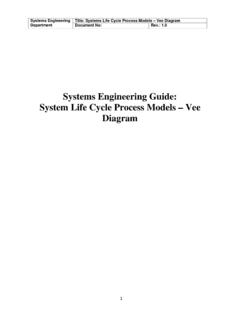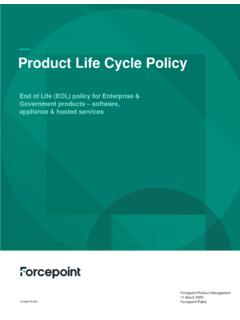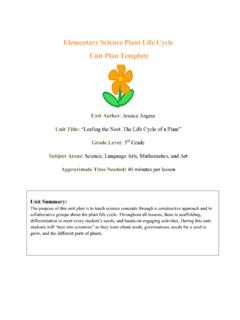Transcription of Life Cycle-Based Sustainability — Standards & Guidelines
1 Numerous Standards and Guidelines have recently been developed by public and private organizations in order to meet society s needs for credible and comparable environmental metrics at the product and organization level. Many initiatives follow a life cycle approach which means that environmental impacts are assessed from the acquisition of raw materials through to manufacturing, distribution, use and end-of- life . The concept is well-known for products, which is generally termed a life cycle assessment (LCA), but is lately also applied to organizations, also called a value chain or scope 3 analysis, for example. A centralized overview of Standards can help companies to better understand the developments of global and regional reporting Standards and Guidelines , which are applicable to their company or products.
2 By being better informed, companies can determine the most appropriate Standards and Guidelines to follow and how to meet the requirements of the individual efforts. This knowledge will enable companies to maximize the benefit of their Sustainability investment. Below we present several well-known, and some lesser known life Cycle-Based protocols and Standards that are in use today. Website links to these documents are provided at the end of this Standards and GuidelinesISO 14040 and ISO 14044 The leading Standards for life cycle Assessment (LCA) are ISO 14040 and ISO 14044. These international Standards focus mainly on the process of performing an LCA.
3 Requirements and Guidelines are given for:- Definition of the goal and scope of the LCA- life cycle inventory analysis (LCI) phase- life cycle impact assessment (LCIA) phase- Interpretation phase- Reporting and critical review of the LCAISO 14040:2006 - Environmental management -- life cycle assessment -- Principles and frameworkISO 14044:2006 - Environmental management -- life cycle assessment -- Requirements and guidelinesLife Cycle-Based Sustainability Standards & Guidelines ISO 14040 ISO 14025 PAS 2050 ISO 14033 ISO 14067 BPX 30-323 ISO 14024 GHG Protocol (Product) Carbon Footprints, Japan ISO 14021 ILCD Carbon Footprints, South Korea ISO 14064 DEFRA GHG Protocol (Value Chain) Bilan Carbone ISO 14046 Water Footprint NetworkProductCorporateCombined2 ISO 14024 (Type I label)Voluntary, multiple-criteria based, third party program developed for a specific product or products.
4 Examples include the EU ecolabel, Blue angel, Ecologo, etc. ISO 14024 - Type I LabelISO 14021 (Type II label)Type II is for any written or spoken environmental statement or claim. There are no fixed criteria, manufacturers simply declare the information they wish to communicate about the environmental attributes of their products. ISO 14021 - Type II LabelISO 14025 (Type III label)ISO 14025 is based on ISO 14040/44 and introduces two concepts: Product Category Rules (PCRs) and Environmental Product Declarations (EPDs). PCRs are specific Guidelines for the calculation of the environmental impact of products with similar characteristics.
5 By following the requirements in the PCR, a company can develop an EPD, which is concise document containing relevant environmental information about a product. PCRs are subject to administration of a program operator. Examples of program operators are Environdec (located in Sweden, with international focus), PlasticsEurope (the Association of Plastics Manufacturers in Europe), Institut Bauen und Umwelt (Germany), EPD-norge (Norway) UL Environment (United States) and JEMAI (Japan). An overview of PCRs from various program operators can be found at: The site of program operator Environdec ( ) also provides PCRs and in addition EPDs.
6 ISO 14025:2006 - Environmental labels and declarations -- Type III environmental declarations -- Principles and proceduresDraft ISO 14067: Carbon Footprint of ProductThis standard is based on ISO 14040/44 and ISO 14025, but focuses on climate change only. Quantification of the carbon footprint of a product (CFP) is largely based on ISO 14040/44, but includes requirements on specific issues relevant for carbon footprints, including land-use change, carbon uptake, biogenic carbon emissions and soil carbon change. The standard also provides specific requirements on communication with or without the intention to be publicly available.
7 Expected publication of this International Standard is the end of Protocol Product Standard: Product life cycle Accounting and Reporting Standard The GHG Protocol product standard has been developed by the World Resources Institute (WRI) and the World Business Council on Sustainable Development (WBCSD) and was road tested by 60 companies in 2010. Like ISO 14067, this standard is largely in compliance with ISO 14040/44, but is specifically focused on greenhouse gas accounting. The standard includes many practical examples. The GHG Protocol product standard was launched in October 2011 and has been adopted as a basis for various industry driven initiatives, including, The Sustainability Consortium1.
8 GHG Protocol - Product life cycle Accounting and Reporting Standard1 The Sustainability Consortium (TSC) drives scientific research and the development of Standards and IT tools, through a collaborative process, to enhance the ability to understand and address the environmental, social, and economic implications of products. The Sustainability Measurement and Reporting System (SMRS) under development will deliver actionable Sustainability information through Category Sustainability Profiles (Level 1), and deliver a large-scale system supporting standardization and harmonization of product LCAs over time (Level 2).3 ILCD: International Reference life cycle Data SystemIn response to the commitments in the Integrated Product Policy (IPP) communication of the European Commission, the Joint Research Centre prepared the ILCD handbook to meet commitments which were made by the European Commission in the Integrated Product Policy (IPP) communication.
9 The ILCD Handbook was published in 2010. It is based on ISO 14040/44, but provides much more detailed technical guidance. The ILCD Handbook contains over 400 pages, whereas ISO 14040/44 jointly contains about 60 pages. The ILCD Handbook contains detailed descriptions and requirements in order to reduce flexibility in choices and to support consistency and quality assurance of LCA results. At the moment, the Environment Directorate General and the Joint Research Center (JRC) are developing a harmonized methodology for the calculation of the environmental footprint of products and organizations. Both methods are based on the ILCD Handbook; PCRs are developed in parallel.
10 International Reference life cycle Data System HandbookPAS 2050: UK s Product Carbon Footprint StandardPAS 2050 was published by British Standards Institution (BSI) in 2008 and revised in October 2011. PAS 2050 was the first carbon footprint standard and has been applied by many companies worldwide. The 2011 revision resulted in a standard that is largely aligned with the GHG Protocol product standard. PAS 2050 - life cycle greenhouse gas emissions of goods and servicesBPX 30-323: French Environmental Footprint GuidanceIn BPX 30-323, the French law Grenelle laid the framework and general methodology for French environmental product labeling.









